Top 5 Local Foods To Eat In Malaysia
My friends complained to me that I have not written a single post on Malaysian delicious local foods which is quite shameful for a Malaysian. Ok Ok, so this is it: The Top 5 Local Foods one travelling to Malaysia must try. For those who doesn’t really know about Malaysian culture, Malaysian consists of 3 major ethnic groups with Malays the majority and followed by Chinese and Indian community. With this multi-ethnic, multi-culture and multi-lingual society, we are lucky to have vast varieties of local foods from multi cuisine and not limited to fusions of them. What I’m going to pick here as my choice of Top 5 local foods are also from these 3 major ethnic community. Without tasting them just to mean that you have not really experienced the true Malaysian. 🙂
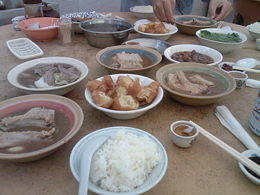 Bak kut teh – A Chinese herb soup that can direct translates as “pork bone tea” It consists of meaty pork ribs in a complex mixes of herbs and spices (including star anise, cinnamon, cloves, dang gui, and garlic), boiled together for hours. It is believed could warm your body and refresh your sleeping mood. Bak Kut teh is usually eaten with rice, and often served with youtiao (strips of fried dough) for dipping into the soup. Soy sauce is preferred as a condiment, with which chopped chilli padi and minced garlic is taken together. Don’t ever forget to drink Chinese tea tohether with your Bak Kut Teh which could help to dilute or dissolve the fat content of meat. Bak kut teh is typically a famous morning meal originally from Klang, Selangor, the home of bak kut teh. Currently, you could find Bak Kut Teh many places all around Malaysia with lots of variants. For RM 10.00, you could order a sinlge portion inclusive of 1 claypot of Bak Kut Teh and 1 bowl of rice. MUST TRY dish!
Bak kut teh – A Chinese herb soup that can direct translates as “pork bone tea” It consists of meaty pork ribs in a complex mixes of herbs and spices (including star anise, cinnamon, cloves, dang gui, and garlic), boiled together for hours. It is believed could warm your body and refresh your sleeping mood. Bak Kut teh is usually eaten with rice, and often served with youtiao (strips of fried dough) for dipping into the soup. Soy sauce is preferred as a condiment, with which chopped chilli padi and minced garlic is taken together. Don’t ever forget to drink Chinese tea tohether with your Bak Kut Teh which could help to dilute or dissolve the fat content of meat. Bak kut teh is typically a famous morning meal originally from Klang, Selangor, the home of bak kut teh. Currently, you could find Bak Kut Teh many places all around Malaysia with lots of variants. For RM 10.00, you could order a sinlge portion inclusive of 1 claypot of Bak Kut Teh and 1 bowl of rice. MUST TRY dish!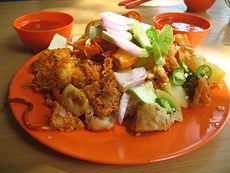 Rojak – A fruit and vegetable salad dish commonly found in Malaysia. The term “Rojak” is Malay for mixture, is also used as a colloquial expression for an eclectic mix, and in particular is often used to describe the multi-ethnic character of Malaysian. Chinese rojak contains mainly local fruits such as mango, pineapple, pomelo with cucumber, prawn friitters mixed with spicy shrimp paste sauce. Penang is one of the famous place for this wonderful salad dish. While Indian rojak contains fried dough fritters, bean curds, boiled potatoes, prawn fritters, hard boiled eggs, bean sprouts and cucumber mixed with a sweet thick, spicy peanut sauce. Traditionally, rojak vendors use modified sidecar motorcycles as preparation counters and to peddle their rojak. These mobile vendors now use modified mini trucks which you could find a lot of them along the street. Off course you could also try out these salad in any of the indian or mamak shops or ‘pasar malam’ (night flea market)in Malaysia. Normally, it would cost RM3.00 per portion.
Rojak – A fruit and vegetable salad dish commonly found in Malaysia. The term “Rojak” is Malay for mixture, is also used as a colloquial expression for an eclectic mix, and in particular is often used to describe the multi-ethnic character of Malaysian. Chinese rojak contains mainly local fruits such as mango, pineapple, pomelo with cucumber, prawn friitters mixed with spicy shrimp paste sauce. Penang is one of the famous place for this wonderful salad dish. While Indian rojak contains fried dough fritters, bean curds, boiled potatoes, prawn fritters, hard boiled eggs, bean sprouts and cucumber mixed with a sweet thick, spicy peanut sauce. Traditionally, rojak vendors use modified sidecar motorcycles as preparation counters and to peddle their rojak. These mobile vendors now use modified mini trucks which you could find a lot of them along the street. Off course you could also try out these salad in any of the indian or mamak shops or ‘pasar malam’ (night flea market)in Malaysia. Normally, it would cost RM3.00 per portion.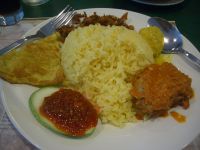 Nasi lemak – The unofficial national dish of Malaysia. With roots in Malay culture, its name is a Malay word that literally means ‘rice in cream’. The name is derived from the cooking process whereby rice is soaked in rich coconut cream and then the mixture steamed. Sometimes knotted screwpine (pandan) leaves are thrown into the rice while steaming to give it more fragrance. Traditionally, Nasi Lemak serves in banana leaves as a platter with cucumber slices, small dried anchovies (ikan bilis), roasted peanuts, hard boiled egg and hot spicy onion sauce (sambal). Nasi lemak can also come with any other accompaniments such as chicken, cuttlefish, cockle, beef curry, beeflungs where all are spicy in nature. You could try this basically everywhere in Malaysia. Depends on the accompaniments and size of portion, it cost from RM1.00 to RM6.00 normally. My bet is to try out those packed with banana leaves in small portion which cost only RM1.00 and they are really delicious. You can’t miss this!
Nasi lemak – The unofficial national dish of Malaysia. With roots in Malay culture, its name is a Malay word that literally means ‘rice in cream’. The name is derived from the cooking process whereby rice is soaked in rich coconut cream and then the mixture steamed. Sometimes knotted screwpine (pandan) leaves are thrown into the rice while steaming to give it more fragrance. Traditionally, Nasi Lemak serves in banana leaves as a platter with cucumber slices, small dried anchovies (ikan bilis), roasted peanuts, hard boiled egg and hot spicy onion sauce (sambal). Nasi lemak can also come with any other accompaniments such as chicken, cuttlefish, cockle, beef curry, beeflungs where all are spicy in nature. You could try this basically everywhere in Malaysia. Depends on the accompaniments and size of portion, it cost from RM1.00 to RM6.00 normally. My bet is to try out those packed with banana leaves in small portion which cost only RM1.00 and they are really delicious. You can’t miss this!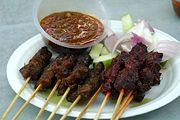 Satay – Chunks or slices of dice-sized meat (chicken, mutton, beef or pork ) on bamboo skewers (although the more authentic version uses skewers from the midrib of the coconut leaf). These are grilled or barbecued over a wood or charcoal fire, then served with a spicy peanut sauce dip, or peanut gravy, slivers of onions and cucumbers, and ketupat (rice cakes). In Malaysia, satay is a popular dish – especially during celebrations – and can be found throughout the country. Turmeric is a compulsory ingredient used to marinate satay and to give it a characteristic yellow color, especially for Beef, Chicken, Mutton and Pork. It can be found throughout every state in Malaysia. Besides restaurants that serve satays, one can find hawkers selling satay in food courts and Pasar malam. The famously known satay outlets are in Kajang, Selangor which dubbed as the Sate City in the country. Sate Haji Samuri is very popular in Kajang as well as throughout Malaysia. One stick of Satay costs normally RM0.50 and bet you could easily eat more than 5 sticks in one go!
Satay – Chunks or slices of dice-sized meat (chicken, mutton, beef or pork ) on bamboo skewers (although the more authentic version uses skewers from the midrib of the coconut leaf). These are grilled or barbecued over a wood or charcoal fire, then served with a spicy peanut sauce dip, or peanut gravy, slivers of onions and cucumbers, and ketupat (rice cakes). In Malaysia, satay is a popular dish – especially during celebrations – and can be found throughout the country. Turmeric is a compulsory ingredient used to marinate satay and to give it a characteristic yellow color, especially for Beef, Chicken, Mutton and Pork. It can be found throughout every state in Malaysia. Besides restaurants that serve satays, one can find hawkers selling satay in food courts and Pasar malam. The famously known satay outlets are in Kajang, Selangor which dubbed as the Sate City in the country. Sate Haji Samuri is very popular in Kajang as well as throughout Malaysia. One stick of Satay costs normally RM0.50 and bet you could easily eat more than 5 sticks in one go!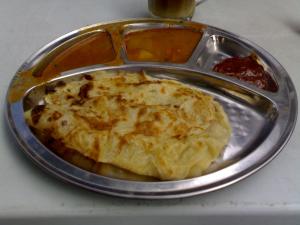
 Roti canai – A type of flatbread or better known as roti prata. Roti means bread in Malay. The term “canai” derives from “Chennai”, a region in India which is formerly known as Madras. In English, roti canai is sometimes referred to as “flying bread,” a term that evokes the process of tossing and spinning by which it is made before frying on the hot pan. The ideal roti is flat, fluffy on the inside but crispy and flaky on the outside. Roti Canai is normally served with beans curry, fish curry or mint source. Some may like to dip it into sugar. One of the characteristics of roti canai and its derivatives is that it can be eaten with the hands, without the need for utensils. It is a convenient dish to consume, while being filling. This characteristic makes it a dish of choice as breakfast or as late night supper. Roti canai costs normally RM1.00 a piece, making it extremely popular. You could try this dish in all mamak restaurants everywhere in Malaysia.
Roti canai – A type of flatbread or better known as roti prata. Roti means bread in Malay. The term “canai” derives from “Chennai”, a region in India which is formerly known as Madras. In English, roti canai is sometimes referred to as “flying bread,” a term that evokes the process of tossing and spinning by which it is made before frying on the hot pan. The ideal roti is flat, fluffy on the inside but crispy and flaky on the outside. Roti Canai is normally served with beans curry, fish curry or mint source. Some may like to dip it into sugar. One of the characteristics of roti canai and its derivatives is that it can be eaten with the hands, without the need for utensils. It is a convenient dish to consume, while being filling. This characteristic makes it a dish of choice as breakfast or as late night supper. Roti canai costs normally RM1.00 a piece, making it extremely popular. You could try this dish in all mamak restaurants everywhere in Malaysia.
Well, although I have only listed the Top 5, there are so much more delicious local foods you could also try out in Malaysia such as Char Kuoy Teow (chinese fried noodle), Pisang Goreng (deep Fried banana), deep fried sweet potato, Nasi Kandang, Asam Laksa, Har Mee (Prawn noodle), Nasi Paprik, and so on. You may comment on my Top 5 if there are better recommendations.
p/s: Thanks to the help of Wikipedia encyclopedia on part of the text and photos without which this post would not be complete. 🙂 – Travel Feeder, your ultimate photo travel blog





Bak kut teh sounds incredibly delicious! I’d like to go to Malaysia someday, so I’ll add that to my list of things to try (I already love satay).
Love the site design by the way…very dynamic!
- August 1, 2008yum yum bak ku teh!
- September 16, 2011